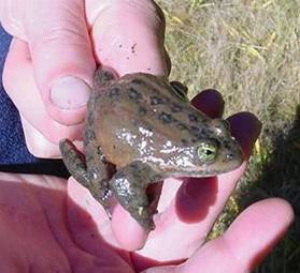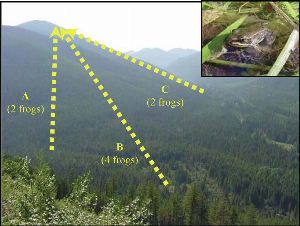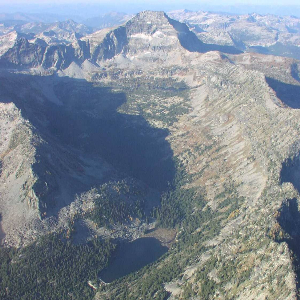Search ARMI Database
Search term(s)
Contribution Number
Search Results
856 record(s) found.
Papers & Reports Understanding amphibian declines through geographic approaches
Authors: A L Gallant
Date: 2003 | Outlet: .S. Geological Survey EROS Miscellaneous Publication GST GAM 001-03
Papers & Reports Range-wide phylogeographic analysis of the spotted frog complex (Rana luteiventris and R. pretiosa) in northwestern North America
Authors: W C Funk; Christopher A Pearl; H M Draheim; Michael J Adams; T D Mullins; S M Haig
Date: 2008-06-04 | Outlet: Molecular Phylogenetics and Evolution 49: 198-210
The dynamic geological and climatic history of northwestern North America has made it a focal region for phylogeography. We conducted a range-wide phylogeographic analysis of the spotted frog complex (Rana luteiventris and R. pretiosa) across its range in northwestern North America to understand its evolutionary history and the distribution of clades to guide conservation of R. pretiosa and Great Basin R. luteiventris, both candidates for listing under the U.S. Endangered Species Act. Mitochondrial DNA sequence data from a segment of the cytochrome b gene were obtained from 308 R. luteiventris and R. pretiosa from 98 sites. Phylogenetic analysis revealed one main R. pretiosa clade and 3 main R. luteiventris clades, 2 of which overlapped in southeastern Oregon. The 3 R. luteiventris clades were separated from each other by high levels of sequence divergence (average of 4.75–4.97%). Two divergent clades were also uncovered within the Great Basin. Low genetic variation in R. pretiosa and the southeastern Oregon clade of R. luteiventris highlights their vulnerability to extinction.
Papers & Reports High dispersal in a frog species suggests that it is vulnerable to habitat fragmentation
Authors: W C Funk; A E Greene; P. Stephen Corn; Fred W Allendorf
Date: 2005 | Outlet: Biology Letters 1: 13–16
We examined dispersal rates in Columbia spotted frogs (Rana luteiventris) using capture–recapture analysis of over 10,000 frogs in combination with genetic analysis of microsatellite loci in replicate basins. We found that frogs had exceptionally high juvenile dispersal rates over long distances, large elevation gains and steep inclines that were corroborated by genetic data showing high gene flow.
Papers & Reports Population structure of Columbia spotted frogs (Rana luteiventris) is strongly affected by the landscape
Authors: W C Funk; Michael S Blouin; P. Stephen Corn; B A Maxell; David S Pilliod; Stephen J Amish; Fred W Allendorf
Date: 2005 | Outlet: Molecular Ecology 14: 483–496
Landscape features such as mountains, rivers, and ecological gradients may strongly affect patterns of dispersal and gene flow among populations and thereby shape population dynamics and evolutionary trajectories. The landscape may have a particularly strong effect on patterns of dispersal and gene flow in amphibians because amphibians are thought to have poor dispersal abilities. We examined genetic variation at six microsatellite loci in Columbia spotted frogs (Rana luteiventris) from 28 breeding ponds in western Montana and Idaho, USA, to investigate the effects of landscape structure on patterns of gene flow.
Papers & Reports Patterns and consequences of dispersal in Columbia spotted frogs (Rana luteiventris)
Authors: W C Funk
Date: 2004 | Outlet: Missoula: University of Montana 140
Papers & Reports Distribution of the herpetofauna of coastal southern California with reference to elevation effects
Authors: Robert N Fisher; T J Case
Date: 2000 | Outlet: Keeley JE, Baer-Keeley M, Fotheringham CJ, editors. Interface between ecology and land development in California 137-143
Papers & Reports Life on the ""island"" – Animals
Authors: Robert N Fisher
Date: 2004 | Outlet: Understanding the life of Point Loma: San Diego, Calif., Cabrillo National Monument Foundation 112-131
Papers & Reports Unusual Subterranean Aggregations of the California Giant Salamander, Dicamptodon ensatus
Authors: Gary M Fellers; L L Wood; S Carlisle
Date: 2010 | Outlet: Herpetological Conservation and Biology In press
Papers & Reports Rana aurora draytonii (California red-legged frog) Predation
Authors: Gary M Fellers; L L Wood
Date: 2004 | Outlet: Herpetological Review 35: 163
Papers & Reports Turning Population Trend Monitoring into Active Conservation: Can we save the Cascades Frog in the Lassen region of California?
Authors: Gary M Fellers; K L Pope; J E Stead; M S Koo; H H Welsh
Date: 2008 | Outlet: Herpetological Conservation and Biology 3: 28-39
Papers & Reports Pesticides in Mountain Yellow-legged Frogs (Rana muscosa) from the Sierra Nevada Mountains of California, USA
Authors: Gary M Fellers; L L McConnell; D Pratt; S Datta
Date: 2004 | Outlet: Environmental Toxicology and Chemistry 23: 2170-2177
Papers & Reports Pesticides in mountain yellow-legged frogs (Rana muscosa) from the Sierra Nevada Mountains of California, USA
Authors: Gary M Fellers; L L McConnell; D Pratt; S Datta
Date: 2005 | Outlet: Environmental Toxicology and Chemistry 23: 2170-2177
Papers & Reports Overwintering Tadpoles in the California Red-legged Frog (Rana aurora draytonii)
Authors: Gary M Fellers; A E Launer; G Rathbun; Steven Bobzien; Jeff A Alvarez; D Sterner; R B Seymour; M Westphal
Date: 2001 | Outlet: Herpetological Review 32: 156-157
In California, overwintering tadpoles have been reported for only two ranid species: Rana muscosa (mountain yellow-legged frog) (Stebbins 1985) and R. catesbeiana (bullfrog) (Behler and King 1979; Leonard et al. 1993). Storer (1925) states that R. aurora spend 4 - 5 months as larvae with metamorphosis typically taking place between July and September. We report here our observations of Rana aurora draytonii (California red-legged frog) tadpoles overwintering at 11 sites spread over four counties in central coastal Cali-fornia. We define overwintering as spending the winter (No-vember - February) in the larval stage (< Gosner stage 40; Gosner 1960).
Papers & Reports California giant salamander, Dicamptodon ensatus Eschscholtz
Authors: Gary M Fellers; S R Kuchta
Date: 2005 | Outlet: Amphibians of the Pacific Northwest 50-53
Papers & Reports California Red-legged Frog (Rana draytonii) Movement and Habitat Use: Implications for Conservation
Authors: Gary M Fellers; Patrick M Kleeman
Date: 2007 | Outlet: Journal of Herpetology 41: 276-286
Papers & Reports Diurnal Versus Nocturnal Surveys for California Red-legged Frogs
Authors: Gary M Fellers; Patrick M Kleeman
Date: 2006 | Outlet: Journal of Wildlife Management 70: 1805–1808
Papers & Reports A Technique for Locating and Recovering Radiotransmitters at Close Range
Authors: Gary M Fellers; Patrick M Kleeman
Date: 2003 | Outlet: Herpetological Review 34(2): 123
Papers & Reports Oral Chytridiomycosis in Mountain Yellow-Legged Frogs (Rana muscosa)
Authors: Gary M Fellers; David E Green; J E Longcore
Date: 2001 | Outlet: Copeia 2001: 945-953
Papers & Reports Demise of translocated populations of mountain yellow-legged frogs (Rana muscosa) in the Sierra Nevada Mountains of California
Authors: Gary M Fellers; David F Bradford; D Pratt; L L Wood
Date: 2007 | Outlet: Herpetological Conservation and Biology 2: 5-21
Papers & Reports Pacific treefrog, Pseudacris regilla Baird and Girard
Authors: Gary M Fellers
Date: 2005 | Outlet: Amphibians of the Pacific Northwest 174-177





